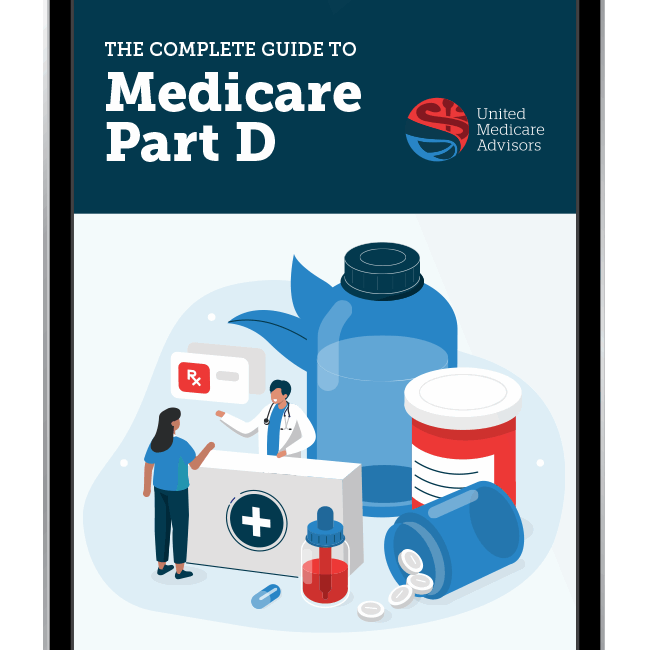Medicare Part D: Prescription Drug Plans
Learn about Medicare Part D & Prescription Drug Coverage through Medicare
Understanding Medicare Prescription Drug Coverage
While Original Medicare covers many medically necessary services, it doesn’t offer coverage or subsidize the cost of prescription drugs — that’s where Medicare Part D comes in. Also called Prescription Drug Plans or PDP, Medicare Part D is designed to help seniors finance the rising costs of prescription drugs and premiums.
Compare your Part D plan options with UMA.
Contact United Medicare Advisors today — We can help!
What is Covered by Medicare Part D?
Formularies & Drug Lists
Medicare Part D encompasses a variety of drug plans, each of which covers its own set list of drugs, also known as a formulary. The cost of a drug plan varies based on which types of drugs you need, and knowing your prescriptions can help determine which plan is right for you. To help you understand how much you'll pay, Medicare Part D plans organize drug lists into different tiers. Generally, the lower the tier number, the lower your cost.
Pharmacies
Choosing the right Part D plan involves more than just checking your drug list — you also need to know which pharmacies are included in the plan's network. A prescription drug plan's pharmacy network is the group of pharmacies that have agreed to provide prescriptions to plan members at a contracted, lower cost. This information should be available through your member portal or by contacting your plan directly.
Within a plan’s in-network pharmacies, you may have access to “preferred in-network pharmacies,” which can save you even more on Medicare Part D costs. Some plans also offer mail-order pharmacies that allow you to get up to a 3-month supply of your prescriptions sent directly to your home.
Using a pharmacy outside of your plan's network will generally mean your prescriptions won't be covered, and you'll have to pay the full retail price. If you do end up using an out-of-network pharmacy, you may be able to submit your receipts to your plan to get a partial refund.
Recommended Reading
How Does Medicare Part D Work?

What is the Cost of Medicare Part D?
Medicare Part D costs aren’t standardized, since plans charge a monthly fee (premium) that varies by plan. The Part D base beneficiary premium is the amount that the government negotiates as the starting point for plan premiums. Based on bids submitted by PDPs and Medicare Advantage plans with prescription coverage, the 2026 amount is $38.99.
In 2026, Part D beneficiaries with higher incomes will also pay an income-related premium surcharge. The projected amounts of the surcharges range from $14.50 to $91.00.
In addition to the premium, prescription drug plans have a slightly confusing cost structure for out-of-pocket drug costs. Here is the breakdown of the most basic model for Medicare Part D costs in 2026:
Medicare Part D Deductibles
Beneficiaries are responsible for 100 percent of the Medicare Part D deductible cost, which is set by their PDP plan. Not all plans charge the full deductible, which is $615 as of 2026.
Initial Coverage for Prescription Drugs
The beneficiary will pay a certain amount for each prescription filled and this is determined by the insurance carrier formulary which lists each drug covered under which tier. The insurance carrier determines the per-prescription cost, but the new overall out-of-pocket limit in 2026 is capped at $2,100 per year across all plans.
Coverage Gaps & Donut Hole Insurance
In previous years, after the initial coverage limit was met, beneficiaries covered 37 percent of generic drug out-of-pocket costs and 25 percent of brand-name drug out-of-pocket costs. In 2020, the gap for generic drugs was closed at 25 percent. The Inflation Reduction Act (IRA) of 2022 effectively eliminated this coverage gap, referred to as the Medicare Donut Hole, meaning the initial coverage phase now continues straight through to the catastrophic phase, eliminating the complex cost shift.
Catastrophic Coverage for Prescription Drugs
This coverage comes into effect when a beneficiary has spent over $2,100 for prescription drugs, as of 2026. Out-of-pocket totals reset at the end of each year.
If you feel like you may benefit from help managing your prescriptions, Medicare also offers the Prescription Payment Plan.
Recommended Reading
Medicare Part D e-book

How to Enroll in Medicare Part D
You can enroll in a Medicare Part D plan during your Initial Enrollment Period. For most people, this window starts three months before your 65th birthday and ends three months after, as long as you’re enrolled in Medicare Parts A and B. If you do not sign up for Part D when you are first eligible, you may have to pay a Part D late enrollment penalty, which is an added monthly cost to your Part D premium.
After you initially enroll in Medicare prescription coverage, you do not need to reenroll every year, but you are able to change your plan annually during the Medicare Annual Enrollment Period (AEP). During this time, you can comparison shop PDP plans and find a better fit for your changing needs. Navigating Medicare Part D plans can be overwhelming, but our licensed agents are here to help simplify the process. We can cross-reference your medications against plans in your service area, help you find options that keep your costs low, and guide you through the enrollment process and beyond.
In this article
Share this now:
Get A Free Quote
Find the Most Affordable Medicare Plans in your Area
